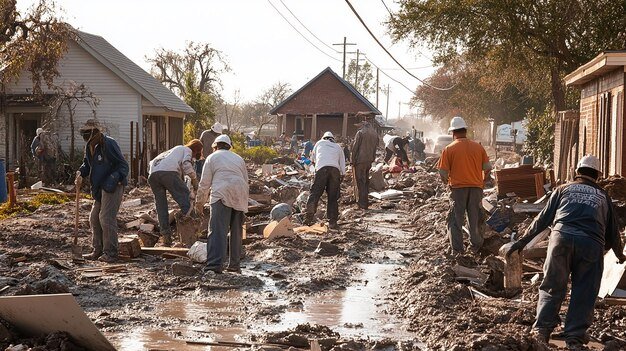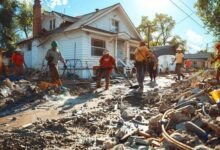Efforts to Restore and Rebuild: A Path Forward After Disaster

Efforts to Restore and Rebuild: A Path Forward After Disaster
There is a potential disadvantage to any natural disaster, whether it be a cyclone, an earthquake, or a flood. These occurrences simulate the restoration of order and the procedures to redress the affected populations. Restoration and reconstruction are more than replacement of the damaged facilities; they also aim at mending the social and economic scars that the calamities have caused to people and societies. This essay is about restoration and rebuilding, its difficulties, and the techniques that aim at ensuring that individuals, communities, or cities come up strong after a threat.
The Importance of Understanding the Immediate Response
This phase occurs right after a disaster has taken place and is called immediate response, which aims at preserving life and dealing with basic necessities. In the hours or days following a serious disaster, efforts that include a search and rescue, provision of meals, clean water and shelter, and repairs of power and communication systems are paramount. Usually, within hours or days, the government and other international agencies are able to respond and assist the impacted area through cash and non-cash transfers.
- The Role of Emergency Services and Rescue Operations
- Rescue operations are led by the Red Cross, FEMA, and other-related authorities, volunteers, and some military personnel. Teams focused on finding and rescuing individuals trapped in rubble or floodwaters are known as search and rescue teams.
2. Temporary Measures
Execution of measures to provide temporary support like the provision of shelters, food, clean water, and treatment services becomes imperative in the days that follow after a disaster has occurred. Relief activities involve the provision of temporary accommodation, usually in schools or public places, for those who have survived the disaster.
Reconstruction: main obstacles
Once the immediate aid has been given, the focus turns to the so-called rebuilding. It can take months or even years to restore what has been destroyed. Rebuilding infrastructure entails the restoration of already existing facilities, and these include road construction and repairs, bridges, utilities, hospitals, and schools, among others. This particular stage of the process can be very intricate and involves organizing a lot of work in relation to the government, the private sector, and foreign humanitarian organizations.
1. Assessment of Damage
The very first thing in the process of rebuilding is to assess the extent of the damage. Engineers, architects, and civil servants are all involved in estimating how much damage has occurred to buildings and the surrounding infrastructure. This serves the purpose of ascertaining which region requires mitigation interventions and which region relocation and rebuilding to appropriate standards will take place.
1. Financing and Resource Management
There is nearly always a lack of finances in the rebuilding processes. It is a necessity for the government to ensure the appropriateness of resource distribution, and in most instances, the rebuilding process tends to depend on external borrowing and monetary assistance. In other instances, the big-scale rehabilitation process would require resources like crowdfunding, donations, and even public-private sector partnerships.
2. Promotion of Sustainability
In the process of rebuilding a community, the emphasis is also placed on how sustainable, durable, and well designed the infrastructural facilities are constructed. Rather than just replacing what was lost, in a number of regions, new building codes are being implemented that help reduce the risk of destruction from future calamities: buildings that can resist floods, stronger levees, earthquake-proof designs, etc. Employment of renewable resources during the rebuilding process, alongside incorporation of green spaces, also prepares societies for changes in the environment, for instance, climate change.
Social and Economic Rehabilitation
Natural calamities do hamper the economic and social life of society as a whole, putting some people out of jobs and affecting their means of survival. There is no doubt that rebuilding a society’s economic status and its social circles is just as important as architectural restoration.
1. Restoration of Economic Stability
The economies of the affected regions are most of the time hard hit after a disaster, with most of the economic activities disrupted due to the destruction of businesses and the displacement of workers. However, in most cases, the local authorities or non-governmental organizations come in to help, and they do the following to ensure that economic stability is restored:
- Financial aid: Most of the small-scale businesses are given soft loans with low interest rates or sometimes even grant aid to enable them to stand on their feet once again.
- Job creation: New forms of employment are usually made available during the course of restoration works, and local people are usually employed to aid in the building back of the physical structures.
- Tourism Recovery: Where the economy is primarily focused on tourism, special measures are taken to restore the tourist sites as fast as possible in order to reorient the economy.
2. Psychological as well as societal rehabilitation
Looking at the experience of a disaster for the victims often bears pain: stress, anxiety, depression, and a host of other issues. Psychological support services must be incorporated in long-term efforts for rehabilitation to deal with the disillusionment of the people. Rehabilitation mechanisms like counseling, support groups, and social programs assist individuals in coping with their experiences and creating ‘normalcy’ again.
Support from the Global Community
Following such calamities, the international community provides assistance primarily in the form of financial support. Enormous amounts of resources are mobilized from private entities, foreign governments, non-profit organizations, and supranational establishments such as the UN, the World Bank, and the Red Cross, among others, for the rebuilding process.
1. Collaboration and Coordination
International agencies engage in partnership with local authorities in the process of rebuilding. This guarantees, among other things, the economy and the efficacy of the process. Especially where the resources of the country or the governance are meager, it is important to also consider cross-sector recovery, that is, public, private, and international.
2. Long-Term Planning and Resilience
World bodies also emphasize strategies for recovery even decades after a calamity to make sure that the communities that are being constructed will be in a way that they will fight off any future destruction. Assuring styles of life where early warning systems are installed, training people to be prepared for any calamity, and carrying out infrastructural development are the best ways of combating future threats.
Toward the Development of a More Resilient World
Restoration efforts after a calamity entail rebuilding; that is true; gentlemen and ladies, however, it also entails building back better, rebuilding more resilient and ‘difficult to destroy’ communities. Rebuilding activities are not a simple process, and each entity—the state, the business, and the individuals—should support the process in a way that their efforts would not be wasted due to the similar events taking place in the subsequent years. It is vital to have proper resources and advanced technologies during the reconstruction process after any form of calamity, for instance, smart city systems, climate-adaptive building designs, and better planning of the infrastructure.

Iowas’s Resarch
- How long does the reconstruction period take after the occurrence of a natural disaster?
- Years and even centuries are acceptable due to recoverable factors involved within the scope of the calamity involved.
- What is the process of international assistance for the affected individuals in the context of the disaster?
- Foreign assistance has a financial, involuntary, and technical aspect that provides a quicker and more efficient recovery. It is also useful in planning for preparedness in anticipation of other disasters.
- How can communities improve their capacity to deal with disasters in the future?
- The implementation of eco-friendly building techniques, spending money on early warning systems, and formulating very good disaster preparedness programs will help communities in dealing with such future situations.
- In the context of disaster response, why is recovery of the economy so important?
- Rehabilitation of businesses and jobs is crucial in ensuring the community’s equilibrium for the member activities and functioning to their normal lives and dealings.
- What types of psychological assistance are provided to the victims of natural disasters?
- Psychological support refers to the provision of counseling, therapy, and other social healing activities for the purpose of helping individuals manage the emotions that follow a disaster.

